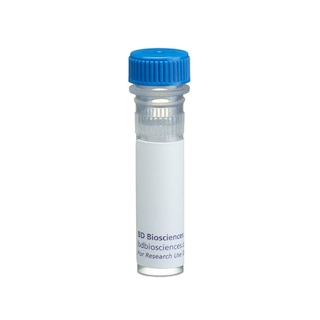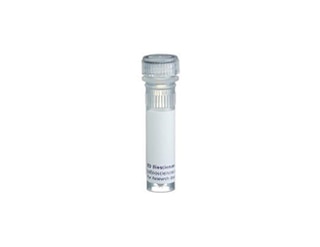-
Your selected country is
Middle East / Africa
- Change country/language
Old Browser
This page has been recently translated and is available in French now.
Looks like you're visiting us from {countryName}.
Would you like to stay on the current country site or be switched to your country?




Immunohistochemical staining of a mouse spleen. A citrate pre-treated, formalin-fixed paraffin-embedded section of a normal mouse spleen was stained with 0.3125 µg/mL of the purified rat anti-mouse CD43 antibody (clone S7) (20X magnification).


BD Pharmingen™ Purified Rat Anti-Mouse CD43

Regulatory Status Legend
Any use of products other than the permitted use without the express written authorization of Becton, Dickinson and Company is strictly prohibited.
Preparation And Storage
Recommended Assay Procedures
Immunohistochemistry: This antibody is recommended to test for immunohistochemical staining of citrate pre-treated formalin-fixed paraffin-embedded sections of mouse spleen or thymus. The isotype control recommended for use with this antibody is purified rat IgG2a (Cat. No. 559073). For optimal indirect immunohistochemical staining, this antibody should be titrated (1:10 to 1:50 dilution, suggested starting range) and visualized via a three-step staining procedure in combination with biotinylated polyclonal anti-rat Ig (Cat. No. 559286) as the secondary antibody and streptavidin-HRP (Cat. No. 550946) together with the DAB detection system (Cat. No. 550880). More conveniently, the anti-rat Ig HRP detection kit (Cat. No. 551013) can be used which contains the biotinylated secondary antibody, antibody diluent, streptavidin-HRP and DAB substrates for use in the staining procedure.
Product Notices
- Since applications vary, each investigator should titrate the reagent to obtain optimal results.
- Source of all serum proteins is from USDA inspected abattoirs located in the United States.
- Caution: Sodium azide yields highly toxic hydrazoic acid under acidic conditions. Dilute azide compounds in running water before discarding to avoid accumulation of potentially explosive deposits in plumbing.
- An isotype control should be used at the same concentration as the antibody of interest.
- This antibody has been developed for the immunohistochemistry application. However, a routine immunohistochemistry test is not performed on every lot. Researchers are encouraged to titrate the reagent for optimal performance.
- Please refer to www.bdbiosciences.com/us/s/resources for technical protocols.
Companion Products






The S7 monoclonal antibody specifically binds to the 115 kDa glycosylated form of CD43 (Ly-48, Leukosialin). CD43 is expressed on IL-7-responsive pro-B cells, plasma cells, peritoneal and splenic CD5+ B cells (B-1 cells), granulocytes, monocytes, macrophages, platelets, natural killer cells, thymocytes, peripheral T cytotoxic/suppressor cells, and most T helper cells, but not resting conventional peripheral B cells. CD43 expression has also been detected on pluripotent hematopoietic stem cells and myeloid, lymphoid, and NK-cell progenitors in the bone marrow. Studies of CD43-deficient mice indicate that CD43 participates in the negative regulation of T-cell activation and adhesion.
Development References (10)
-
Gulley ML, Ogata LC, Thorson JA, Dailey MO, Kemp JD. Identification of a murine pan-T cell antigen which is also expressed during the terminal phases of B cell differentiation. J Immunol. 1988; 140(11):3751-3757. (Immunogen: Flow cytometry, Western blot). View Reference
-
Hardy R, Hayakawa K. Generation of Ly-1 B cells from developmentally distinct precursors. Enrichment by stromal-cell culture or cell sorting. Ann N Y Acad Sci. 1992; 651:99-111. (Biology: Western blot). View Reference
-
Hardy RR, Carmack CE, Shinton SA, Kemp JD, Hayakawa K. Resolution and characterization of pro-B and pre-pro-B cell stages in normal mouse bone marrow. J Exp Med. 1991; 173(5):1213-1225. (Biology). View Reference
-
Jones AT, Federsppiel B, Ellies LG, et al. Characterization of the activation-associated isoform of CD43 on murine T lymphocytes. J Immunol. 1994; 153(8):3426-3439. (Biology: Western blot). View Reference
-
Moore T, Bennett M, Kumar V. Transplantable NK cell progenitors in murine bone marrow. J Immunol. 1995; 154(4):1653-1663. (Biology). View Reference
-
Moore T, Huang S, Terstappen LW, Bennett M, Kumar V. Expression of CD43 on murine and human pluripotent hematopoietic stem cells. J Immunol. 1994; 153(11):4978-4987. (Biology). View Reference
-
Rolink A, ten Boekel E, Melchers F, Fearon DT, Krop I, Andersson J. A subpopulation of B220+ cells in murine bone marrow does not express CD19 and contains natural killer cell progenitors. J Exp Med. 1996; 183(1):187-194. (Biology). View Reference
-
Stockton BM, Cheng G, Manjunath N, Ardman B, von Andrian UH. Negative regulation of T cell homing by CD43. Immunity. 1998; 8(3):373-381. (Biology). View Reference
-
Thurman EC, Walker J, Jayaraman S, Manjunath N, Ardman B, Green JM. Regulation of in vitro and in vivo T cell activation by CD43. Int Immunol. 1998; 10(5):691-701. (Biology). View Reference
-
Wells SM, Kantor AB, Stall AM. CD43 (S7) expression identifies peripheral B cell subsets. J Immunol. 1994; 153(12):5503-5515. (Biology). View Reference
Please refer to Support Documents for Quality Certificates
Global - Refer to manufacturer's instructions for use and related User Manuals and Technical data sheets before using this products as described
Comparisons, where applicable, are made against older BD Technology, manual methods or are general performance claims. Comparisons are not made against non-BD technologies, unless otherwise noted.
For Research Use Only. Not for use in diagnostic or therapeutic procedures.